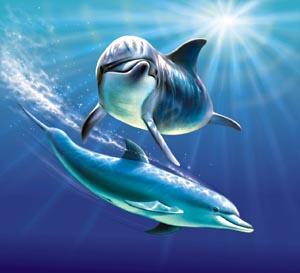THERE IS GOOD
evidence for the view that man/boy love is rooted in our earliest
social evolution. If true, then no amount of suppressive
legislation, beefed-up police powers, or psychological conditioning
will ever be able to eradicate it without fundamentally altering and
impairing something essential and vital in human nature.
Intergenerational homosexuality has been observed repeatedly in one of
the most intelligent creatures on the planet. Dolphins not only
engage in homosexuality, but also the cetaceous equivalent of
boy-love. In what has come to be regarded as the "classic
observations of dolphins at the Marineland of Florida," marine
biologists A.F. McBride and D.O. Hebb published their
findings in the Journal of Comparative and Physiological
Psychology. Their landmark study revealed that sexual play among
young male dolphins was so common it seemed to typify a pre-adult
stage. Not as common but nonetheless frequent were sexual
encounters between maturing male dolphins and fully adult males.
These liaisons were not matters of dominance and submission.
Indeed, the younger dolphins often sought out the older males.
Force or coercion never appeared in such contacts.
As McBride and Hebb reported, "In the spring of 1940, there were two
large males in the tank and two younger males, smaller and
subordinate.... The two larger males repeatedly attempted
intromission with the younger ones. In the homosexual activity
the active (or `male') male swims upside-down under the passive (or
`female') male."
The legendary links between human and dolphin may be closer than we
ever suspected, especially if Desmond Morris, the popular science
writer, is correct in his belief that both humans and dolphins share
the same evolutionary path until some common ancestor decided to make
its home in the sea, leaving us behind on the shore (see his The Human
Zoo). In any case, intergenerational same-sex behavior is
commonly displayed among a higher species with which people feel
emotionally akin (for whatever reasons), adequately demonstrating that
such behavior is by no means "unnatural."
If American moralists are scandalized by the dolphin's sex practices,
how much more offended might they be by the behavior of their own
ancestors, the founders of western civilization, more than 4000 years
ago? In his deeply researched investigation of the Indo-European
peoples of the third millennium B.C., Rick Fields recreated their
ceremonial life: "Very probably they practiced ritual pederasty, like
some of the warriors in New Guinea. This custom was known among
warrior societies in Sparta and Crete, where young boys were 'captured'
by older warriors as part of initiation. It was also found among
the Celts and Germans."
While it is generally known to have been accepted among ancient Greeks
and Romans, this far older Indo-European behavior demonstrates that
boy-love extends back in time thousands of years to the very roots of
civilized humankind. It also contradicts the assertion that
homosexuality exists only when a civilization becomes over-crowded and
declines, giving rise to "unnatural" social practices, since the
Indo-European peoples of that period did not build cities and lived
very close to nature in scattered population groups. History
tells us that the culture-bearers who arose from "ritual pederasty"
gave us the Greek, Roman, Celtic, and Germanic civilizations, which the
haters of boy-love seem to enjoy, nonetheless.
Obviously, man/boy-love has been part of our human heritage from the
beginnings of civilization, if not long before, as parallel behavior
among our dolphin cousins indicates. To suddenly condemn such a
natural, age-old impulse is to thwart the millennial course of
historical development. Who are the real perverts?
 These few facts represent a relative splinter
of information from the vast body of evidence supporting the virtue of
man/boy-love. Unfortunately, none of it counts for anything among
the moral demagogues and their emotionally manipulated followers,
because the mob-mentality, deranged by passionate hatred, is oblivious
to reason. It may nevertheless be salubrious for us to know that
"the love ashamed to speak its own name" was regarded with religious
reverence from the golden ages of prehistory and is still freely
celebrated by our dolphin friends. In that, perhaps, we may take
an extra measure of quiet pride. These few facts represent a relative splinter
of information from the vast body of evidence supporting the virtue of
man/boy-love. Unfortunately, none of it counts for anything among
the moral demagogues and their emotionally manipulated followers,
because the mob-mentality, deranged by passionate hatred, is oblivious
to reason. It may nevertheless be salubrious for us to know that
"the love ashamed to speak its own name" was regarded with religious
reverence from the golden ages of prehistory and is still freely
celebrated by our dolphin friends. In that, perhaps, we may take
an extra measure of quiet pride.
Notes:
Devine, Eleanore and Clark, Martha, The Dolphin Smile, 29 Centuries
of
Dolphin Lore, New York: 1967, Macmillan, page 128.
Fields, Rick, The Code of the Warrior in History, Myth, and
Everyday
Life, New York: 1991, Harper Perennial, page 63.
|

